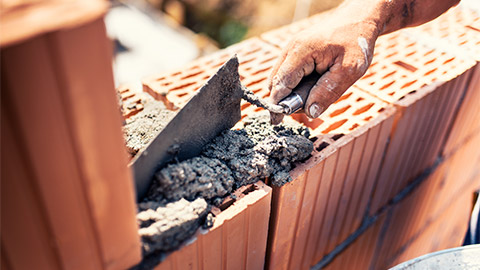Once you have obtained your measurements, it is time to calculate the materials that are needed for the task. For whatever measurements you take, you will need understand the formula to carry out the calculation to determine the accurate number of resources or materials you will need.
Before we look at closely calculations in detail, let’s have a quick look at the shapes that you will be working with. The following table illustrates the common shapes you will be working with along with a description.
Rectangle
Square
Circle
Triangle
Trapezoid
Cube
Cylinder
Triangular Prism
Trapezoidal Prism
- Rectangle
A rectangle is any shape that has four straight sides, and all internal angles are 90 degrees. A rectangle has a longer side and a shorter side. - Square
A square has four equal, straight sides and all internal angles are 90 degrees. - Circle
A circle is a closed, continuous curve in which every point on the curve is an equal distance from the centre. - Triangle
A triangle has three joined, straight edges. - Trapezium / Trapezoid
A trapezium has four straight, joined sides. Two are parallel (equal distance apart at both ends – think of the outside rail on train tracks, even if they went on forever, they would never meet) and two are not. - Cube
A cube is a three-dimensional shape, made up of six, equal-sized squares. - Cylinder
A cylinder is a three-dimensional shape formed by joining two circles of equal size by parallel lines (think of a can). - Triangular Prism
A triangular prism has two triangle bases and three rectangular sides - Trapezium / Trapezoidal Prism
A trapezium/ trapezoidal prism has two trapeziums as the base and four rectangles connecting the bases
Fun fact
A three-dimensional shape (prism) is also called a polyhedron. Polyhedrons have straight sides and flat surfaces. The name Polyhedron is of Greek origin with Poly (meaning many) hedron (meaning base)
We are going to look at how to make calculations of shapes. This includes:
- perimeter
- circumference
- area
- volume.
Calculating perimeter
The perimeter is the total distance around the outside edge of a shape. For example, calculate the amount of formwork that you will need for the edge of a slab or calculate the amount of guttering that you will need for a project.
To calculate the perimeter of shapes with straight edges is a relatively straightforward job. But, first, add the measurements of all sides together.
We will now take a look at how to calculate the perimeter and the formula to use to help you.
Calculating the perimeter of a rectangle
To calculate the perimeter of a rectangle, you add the length + width + length + width (the measurements of all sides). So, the formula for calculating the perimeter of a rectangle is:
Perimeter (P) = Length (L)+ Width (W) + Length (L)+ Width (W)
You may have noticed that you have two equal lengths and two equal widths, so you can also write the formula as:
Perimeter (P) = 2 x (L + W)
Calculating the perimeter of a square
To calculate the perimeter of a square, you only need the measurement of one side (because all four sides are equal). So, the formula for calculating the perimeter of a square is:
Perimeter (P) = Side 1 Length (L) + Side 2 Length (L) + Side 3 Length (L) + Side 4 Length (L)
or
Perimeter (P) = 4 x Length (L)
The following video illustrates a step by step guide for calculating the materials required for a path; the emphasis on this video will be around the perimeter measurements.
Calculating the perimeter of triangles and trapeziums
To calculate the perimeter of a triangle or trapezium, you need each side's measurement and then add them all together.
So, for a triangle:
Perimeter (P) = Side 1 + Side 2 + Side 3
And, for a trapezium:
Perimeter (P) = Side 1 + Side 2 + Side 3 + Side 4
Calculating the perimeter of circles
To calculate the perimeter of a circle (its circumference [C]), you need to know its diameter. The diameter of a circle is the measurement between its two widest points.
Remember that the radius of a circle is the measurement from its centre to its outside edge, so you can calculate the diameter by doubling that number:
Diameter (D) = 2 x Radius (R)
To calculate the circumference of the circle, we use pi (π):
Circumference (C) = pi (π) x Diameter (D)
Pi (π) is the ratio of the circumference of a circle to its diameter. Regardless of the size of the circle, this ratio doesn’t change. Pi is used as a decimal value in several mathematical calculations for circles and cylinders. You will see it written as pi or π. Pi is an irrational number which means that its decimal form continues endlessly. So that we can use it easily, we round it off. Commonly to two or three decimal places. In this resource, we have rounded it off to four decimal places which are 3.1416.
Calculating area
The area is the size of a surface. In building and construction, it is most commonly expressed in square metres (m2) or square millimetres (mm2). When thinking about area, try thinking about it as the number of one-metre x one metre (or millimetre) sheets of paper that you could fit on the surface that you are measuring.
The area calculation is used for working out things like:
- the amount of floor covering to order
- how much paint you will need
- how much plasterboard to order
- the total floor area of a building or the size of a room.
Calculating the area of a rectangle or square
To calculate a rectangular or square surface area, you multiply the length (L) by width (W). So, a sheet of paper that is 1 m x 1 m would have an area of 1 m2.
Area (A) = length (L) x width (w)
Imagine that each of these blocks is 1 m x 1 m (or 1 m2). There are 25 blocks in this room, so the area of the room would be 25 m2.
The following video outlines the requirements for calculating the area of a concrete footpath to determine the materials needed for the job.
Calculating the area of a triangle
To calculate the area of a triangle, you need to know the measurement of its base (B) and its height (H).
The formula for calculating the area of a triangle is:
Area = ½ x (base x height)
or
Area = 0.5 x (B x H)
Calculating the area of a circle
To calculate the area of a circle, you need to know the measurement of its radius. Keep in mind that the radius is half of the diameter.
The formula for calculating the area of a circle is:
Area (A) = π x the square of the radius (R2). The square of the radius means the radius times itself. For example, if the radius was 300 mm, the square of the radius would be 300 mm x 300 mm. So:
Area (A) = π x R x R
or
A = πR2
Calculating the area of a trapezium
A trapezium (also known as a trapezoid) is a quadrilateral shape, meaning it has four sides; however, it is classified as irregular.
To calculate the trapezium area, you first need to add the measurements of a + b (the parallel sides) half it and multiply the answer to the measurement of the height.
A = 1/2 (a + b) x h
or
A = 1/2 h (a + b)
Calculating volume
Volume is the amount of space within an object. For example, you might use volume calculations to determine how much concrete you will need to fill the formwork for a slab. Or how much soil will be removed from a trench. Volume is expressed in cubes. So cubic metres (m3) or cubic millimetres (mm3).
Calculating the volume of a cube
To calculate the volume of a cube (V), multiply the length (L) x width (W) x height (H). So:
Volume (V) = length (L) x width (W) x height (H)
or
V = L x W x H
If you are having trouble picturing the concept of volume, try imagining a cube of 1 m x 1 m x 1 m (like a big dice). This big dice would = 1 cubic metre (1 m3). Now imagine stacking layers of dice inside a box that measures 5 m x 5 m x 5m. There would be 125 dice inside the box – 5 layers of 25 (5 x 5 x 5). So the volume of the box would be 125 dice (or 125 m3).
The following video outlines the process of how to calculate the volume of a slap to determine the amount of concrete you will need to fill it.
Calculating the volume of a cylinder
To calculate the volume of a cylinder, calculate the area of the circle at one end and multiply it by the height of the cylinder:
= (πR2) x H
Calculating the volume of a trapezium
When calculating the volume of a trapezium, you need to half the sum of parallel sides (a + b) then multiply the height (H) by the length (L)
V= ½ (a + b) x H x L
Calculating the area of a triangular prism
When calculating the area of a triangular prism, you need to work out the measurement of half of the base (b) and height (h), then multiply it by the length (l)
V = ½ x b x h x l
Ratios
Ratios are the comparison of amounts. You will often use ratios when mixing substances like concrete. A ratio tells you what quantity of Part A needs to be added to what quantity of Part B. You will see ratios expressed as Part A to Part B or A: B.
A ratio of 1:5 tells you that 1 quantity (it could be litres, kilograms etc) of Part A should be mixed with 5 equal quantities of Part B. For example, the ratio of water to cement when mixing concrete is often 1:4. So, if you add 1 kg of water to the mix, you would add 4 kg of cement.
Weight
Weight is a useful calculation when considering your materials handling requirements. To calculate weight, you will need to know the average weight of the material per cubic metre (or cubic mm). This information is generally available online or from the manufacturer. It may also be in your plans and specifications.
To calculate the total weight of the materials that require moving (or handling), calculate the volume and multiply it by the material’s weight per cubic metre.
Total weight = Volume x weight per unit
For example, if you were breaking up an old slab with the following dimensions for removal and would like to calculate the total weight of concrete to be disposed of, you would:
Step 1
Calculate the volume
V = L x W x H
5 m x 2m x 0.3m = 3 m3
Step 2
Multiply the volume by the average weight of 1 m3 of concrete (2 300 kg)
Total weight = V x average weight of one unit
3 m3 x 2 300 kg = 6 900 kg
Percentages
Often, you will want to add an error margin to a materials order. Or perhaps you might need to mix more of a substance than you have calculated that you need to allow for wastage. For example, when mixing concrete, you will generally allow for 10% (10 per cent) wastage.
A percentage is a way of expressing a fraction or a part of 100. So 10% is 10 parts out of 100 parts (remember ratios).

We have learnt thus far that calculations and measurements are integral to construction; however, if these measurements and calculations are inaccurate, then the entire project is at risk. We will now take a look at how to ensure accuracy is maintained throughout the measurement and calculation process.
Show your working
When recording your measurements and calculations, show your formulas and the working out you used to achieve your answer. By showing your work, if there is a mistake or error in your work, it makes it easier to go back and correct any errors later.
Double-check all errors and calculations
You have probably heard the expression ‘Measure twice, cut once.’ This principle also applies to calculations. Avoid problems down the track, costly delays, and wastage by double-checking all of your calculations. It may seem repetitive to check and check again; however, if you do not have accurate calculations, the impact will be much worse.
Pay attention to detail
Record all of your measurements and calculations neatly and systematically. You need to ensure all measurements and calculations are clearly visible and organised according to the object or area you are working on.

The area calculation is useful for things like working out how much floor covering is required or how much plasterboard to order. But how do you apply that in practice?
Step 1
Calculate the area that you are working on.
A = L x W
Step 2
find out from the manufacturer how the material is supplied. For example:
- you will require 48.5 standard-sized bricks to build one square metre of wall
- one sheet of 2400 x 1200 x 10 mm plasterboard covers 2.88 m2.
Step 3
Calculate how much of the material you will require to cover the area by either multiplying or dividing.
Let’s look at some examples.
This wall is 6 m wide and 3 m high, so its area is 18 m2. (A = L x W)
It’s important to remember that you usually can’t order part of something when calculating quantities of materials. For example, half a brick or a piece of a sheet of plasterboard so you would round up. If you needed 10.2 pieces of plasterboard, you would order 11 pieces of plasterboard.
Bricks

It is inevitable at some stage of your career in construction; you will need to use bricks.
When looking at bricks, we need 48.5 bricks to build one square metre of a wall so, to calculate the total number of bricks that we need, we multiply the area by 48.5.
Quantity = 18 (A) x 48.5
The number of bricks required = 873.
Plasterboard

To calculate the plasterboard, we again start with an area of 18 m2. However, this time, we know from the manufacturer that a single board covers more than one unit of measure – it covers 2.88 m2. So, in this case, we divide.
Quantity = 18 (A)÷ 2.88
The number of boards required = 6.25
Calculating concrete

When you are calculating the amount of concrete that you will need, there are some key concepts that you should keep in mind. These include:
- you will need to know the area and the thickness of the slab to calculate the volume. That will give you the volume of the concrete that you require
- you should factor in 10% waste
- concrete is usually ordered in increments of 0.2 (although some companies accept orders in increments of 0.1).

